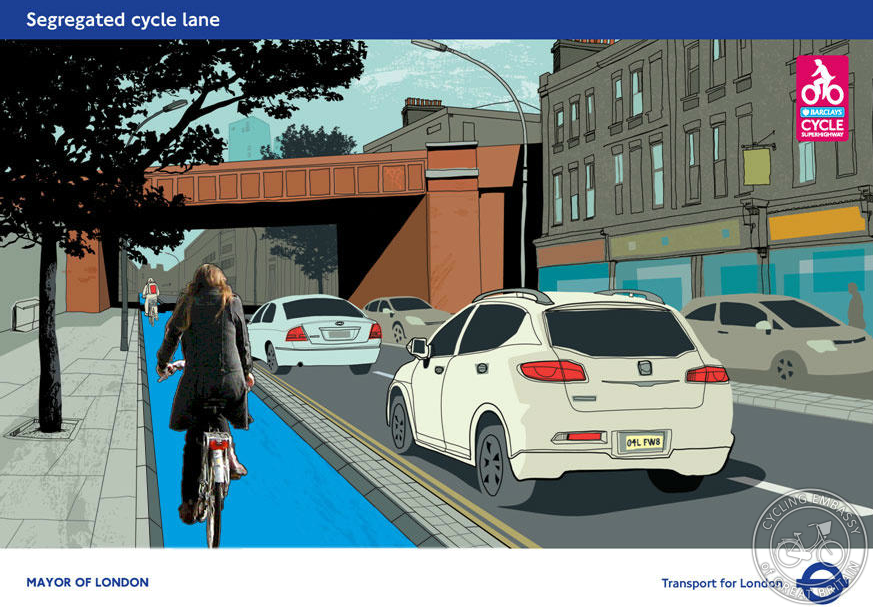Superhighway 2 Extension - Consultation Response
We are strongly in favour of the proposed cycle track along Stratford High Street, kerb-separated from motor traffic, and achieved by reallocation of carriageway space.

Picture adapted by @AlternativeDfT
We also approve, in principle, of the bus stop bypass design, which will remove the need for buses to overtake cyclists between stops, and for cyclists to negotiate out into fast motor traffic to overtake stopped buses. We would like to see smoother curves in the track and more gentle vertical deflection than the mock-ups suggest. Clarity of design is essential, with good visibility for all parties, and appropriate clearly-marked crossing points for pedestrians.
The design of the Superhighway should be suitable for all categories of bicycle user. We do not think ‘less confident’ and ‘more confident’ cyclists should require two different kinds of treatment, as the consultation suggests at some junctions. High-quality infrastructure based on best continental practice should incorporate safety, comfort and convenience, and not trade off these attributes against one another.
We would like to see forgiving, sloping kerbs on either side of the track, which would increase its effective width by allowing people to cycle much closer to the edges.
More detailed comments
We feel that the proposals for Section 1 of the Cycle Superhighway lack ambition and fall short of the quality of other sections. While the 1.8m wide cycle lane proposed in this section is no doubt some improvement over the current design for existing confident cyclists, and we therefore do not object to the proposed changes, we urge TfL to reconsider the designs and to employ here more of the Dutch-style solutions used in other sections. The quality separation proposed in other sections would be a step change that would enable cycling for a far greater (and more diverse) range of people, but the lower quality of the proposals for this section risk compromising the usability of the full route. Anyone wishing to use the proposed cycle lane will have to cycle between buses moving in and out of bus stops, and a significant volume of motor traffic passing close by at 30+ mph. Given the space available at this location, we would prefer to see a wide, kerb-separated track, as proposed on Stratford High Street, rather than a cycle lane.
We would also like to see some form of separation from buses on the eastbound route in this section. There is adequate space for a dedicated cycle track here, away from the movement of motor vehicles and pedestrians. Properly conceived, the 'shared use' pavements here could be abandoned, and restored to pedestrian-only use.
The ASLs on Stratford High Street itself at the junctions of Cam Road, Rick Roberts Way and Abbey Lane seem unnecessary, given that there is a wide-kerb protected track along the High Street. The ASLs at the Rick Roberts Way junction are potentially dangerous as they may tempt cyclists into attempting right turns from lane 1, with motor vehicles progressing straight on from lane 2.
The method for making right turns at the large junction of Rick Roberts Way appears to be by progressing through the junction, then mounting the pavement to enter the ASL in the side road, and waiting for a green signal. While this allows right turns to be made without having to negotiate across multiple lanes of motor traffic, and resembles (in principle) the Danish 'left hook' method of making these turns, we feel that there is possibility for confusion, and conflict with pedestrians. We would like to see dedicated cycle-specific waiting areas for those on cycles waiting to complete the second stage of a right turn, either on the Danish model, or the superior design of the Dutch model, which incorporates protected kerbs.
Finally, in Section 5, at the western end of Stratford High Street, we feel that rather than providing an eastbound cycle lane and shared use pavement for westbound travel on the eastbound section, a two-way segregated cycle track is more appropriate. There is ample pavement space here which can be partially reallocated, and would leave the rest of the pavement free for pedestrian use only. The arrangement of the bus stop and cycle lane near the junction of Marshgate Lane is not adequate. We feel the buses should stop in the eastbound carriageway; this would create sufficient space for an appropriate cycle track bypass behind the bus stop, similar to the good design employed elsewhere on Stratford High Street.
More details here and here. To respond to the consultation, visit TfL's page here (closes today, Monday 11th February)
| Attachment | Size |
|---|---|
| 16.59 KB |
